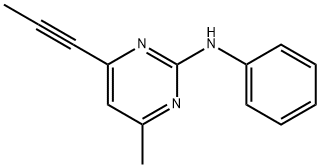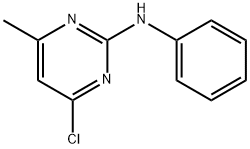Uses
Mepanipyrim is a non-systemic fungicide that provides preventative
control of diseases in pome fruits (scab), vines, strawberries, tomatoes
and cucumbers (grey mould) and peaches (brown rots) caused by Botrytis
cinerea, Venturia inaequaris and Monilinia fructicola.
Uses
Agricultural fungicide.
Uses
Mepanipyrim is an anilinopyrimidine fungicide which have been used in the management of fungal diseases in strawberries.
Definition
ChEBI: A member of the class of aminopyrimidines that is N-phenylpyrimidin-2-amine carrying additional methyl and 1-propynyl substituents at positions 4 and 6 respectively. A fungicide used to control a wide range of diseases including grey mou
d on strawberries, tomatoes and cucumabers, and scab on apples and pears.
Metabolic pathway
By tomato seedlings, 14C-mepanipyrim is
biotransformed via the pathways including elimination
of the phenyl group, hydroxylation of the propynyl
moiety, and hydroxylation at the phenyl ring to yield
several kinds of metabolite, and 2- and 4-[4-methyl-6-
(1-propynyl)pyrimidin-2-ylamino]phenols, 1-(2-anilino-6-
methylpyrimidin-4-yl)-2-propanol, and 4-methyl-6-(1-
propynyl)pyrimidin-2-ylamine are tentatively identified
as major metabolites. In soils under laboratory
conditions, 14C-mepanipyrim undergoes degradation to
give the degradation products and the main pathway
is elimination of the phenyl group.
Degradation
Mepanipyrim (1) is stable to hydrolytic degradation in the pH range
4-9 with a DT
50 >1 year. It decomposed rapidly in water when exposed
to light (DT
50 13 days) (PM).




